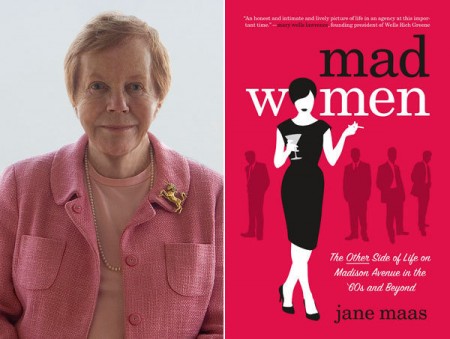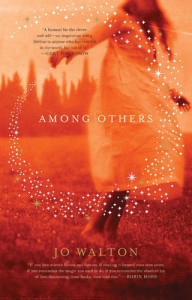I absolutely loved this book. Every woman (and man) who loves Mad Men should read Mad Women by Jane Maas, which is about what it was actually like to be in advertising in the 60s. Jane Maas has great insights here because she began her career at Ogilvy & Mather as a copywriter in 1964 and climbed the ladder to creative director and agency officer. The book offers a ton of little stories and tidbits on what it was like to work at the agency and with David Ogilvy. Maas also ran her own agency, was a Matrix Award winner and an Advertising Woman of the Year, and if you have no idea who she is, think about the I Love New York campaign. Maas was the director of the campaign and shepherded it to greatness.
Mad Women is a book of anecdotes about Maas, the agencies of the 60s, career women and what’s accurate (and less so) in the tv series Mad Men. I thought the book was hilarious and intriguing. I mean it is a bit of bragging, but so what. Peggy Olson is a ringer for Maas, who rose through the ranks based on merits and managed some rather large accounts. The book is well written and if you’re at all interested in storytelling, it’s like having lunch with Maas and shooting the shit about the golden days of advertising.
The big takeaways: Career women seem to have all the same challenges today that they did in the 60s, although perhaps the discrepancies between men and women are more muted today than they were in the 60s. And advertising campaigns and their behind-the-scenes battles are pretty much the same.
Campaigns
Maas references a ton of great campaigns and the women behind them. For example, Clairol’s hair coloring. Coloring your hair in the 60s was a topic more personal than sex, mostly because only showgirls and hookers colored their hair. The woman behind Clairol’s “Does she … or doesn’t she?” slogan was Shirley Polykoff.
I Love New York is one of the most famous ad campaigns in history and many people claim to be the creator, but Maas was the liaison between the agency and the governor, the Department of Commerce, the state legislature, the regional tourism offices, the League of New York Theaters, the Statue of Liberty, the Baseball Hall of Fame, the Rockettes, the White House, and the Olympic Committee.
Mad Men: True or False
Was there much sex in the office? Joan Lipton, one of the grandes dames of advertising says “of course people were partaking, but you have to understand that at the time I was married, had a three-year-old child, and was living in Connecticut. In her interview Maas suggests then that Lipton was aware then of the sexual activity. “Aware?” Joan sniffed. “Heavens, I partook.”
Was there that much drinking? One account man complains to Jane, “it’s not at all realistic. We never drank in the morning.” Seems that it was customary to go out for lunch/liquid lunch most days. “We’d then have wine during lunch and a Rusty Nail (a combination of whisky and Drambuie) or Stinger (a lethal concoction of white creme de menthe and brandy) to finish. Then unbelievably, we’d all go back to our offices at about 2pm to work.”
From an Adage interview: Do you think Mad Men is accurate in its portrayal of women? Maas says “Yes, I do. For instance, Peggy Olson has a career path very similar to mine; she started off as a secretary and then got to writing copy by pleading, and then writing copy on nights and weekends until finally she was promoted to a copywriter. Still, a lot of her ideas are met with poo poo because the men think they know better. I think that’s very realistic in terms of how women copywriters were treated in those days — they were only allowed to work on certain types of products like baby food and things like that.”
The smoking: Maas recounts, “just an hour after my daughter Kate was born, a nurse brought this tiny 5lb infant to my hospital bed and I remember cradling her in one arm and smoking a cigarette with the other hand.”
The hats are missing: Women copywriters wore a hat all day long. It was a badge that signaled your position above the typing pool.
Stuff I Learned
1967: The teamwork school of creativity where the copywriters and art directors come up with ideas together was a new Doyle Dane Bernbach concept only recently implemented by agencies. Bill Bernbach decreed that at his agency, copywriters and art directors must work together on all advertising‚ even radio scripts. Maas, “We hear that at DDB some art directors can’t even draw. Imagine.”
The Schools of Advertising:
Quote: Doyle Dane school: tell it like it is, avoid hyperbole, have a little fun with the products. Ads like “Think small” for Volkswagen. “You don’t have to be Jewish to like Levy’s Jewish rye,” for a bakery in Brooklyn … and “We’re only #2. We try harder” for Avis.
David Ogilvy school: persuasive ads that often have long headlines and a lot of copy, packed with facts. One of DO’s most famous headlines was for Rolls-Royce, “the visual was simply a sleek photo of a car. The headline said: ‘At 60 miles an hour, the loudest noise in this new Rolls-Royce comes from the electric clock.'”
Ted Bates school: “hard-hitting, hard-selling advertising that drives the message home with powerful visuals and taglines repeated over and over. Hammers pounding on an animated head for Anacin; stomach acid bursting into flames for Tums. When people talk about how irritating advertising can be, it’s usually this kind of work they have in mind.”
Gene Grayson is a school unto himself. “He specializes in mnemonic devices‚ usually a visual effect that helps the consumer remember your brand and what it stands for. For Maxim freeze-dried coffee he created the slogan ‘Turns every cup in your house into a percolator.'”
To whet your appetite for mad women, listen to The Age of Persuasion on the great women of advertising. And do read Mad Women one. Totally fun and worth the ride.
Mad Women: The Other Side of Life on Madison Avenue in the ’60s and Beyond by Jane Maas
Published by St. Martin’s Press

